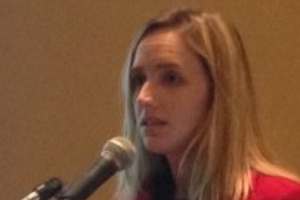With MDR, XDR TB growing, risk response needed for students, researchers, healthworkers, ASTMH 2013 Conference speakers say
Dr. Edward Nardell of Harvard Medical School was sitting in his office one day when a student called to ask if he had any advice on how to avoid contracting drug-resistant tuberculosis.
The student was heading to KwaZulu Natal, where rates of drug-resistant tuberculosis are among the highest in the world, and where the student’s task would be to collect sputum samples from people with suspected TB.
“Yikes,” Nardell remarked, recounting the incident Thursday during a session at the American Society of Tropical Medicine and Hygiene 2013 annual meeting. The rest of his advice to the student was: Find another project to work on.
“I think we do a bad job of educating people what the risks are,” he said. In a time when more medical students and researchers from low TB incidence countries are exploring global health challenges, programs need to assess students’ TB risks and provide guidelines based on those risks, he said. A few years ago he developed a list of guidelines that, he said, circulated around Harvard until they reached the lawyers’ office. With the warning that recognizing those risks would mean owning responsibility for them, the guidelines were put aside he said.
Nardell, whose interest in TB control was sparked during a 1983 outbreak of drug resistant tuberculosis in a Boston homeless shelter when he was the city health department’s TB Control officer, was joined in discussing some of the systemic gaps leaving medical students, researchers, and health workers unprotected from the disease, by Dalene von Delft, a pediatrician and a founder of the South-Africa based TB Proof.
“Are you TB proof?” she began, with photos of Eleanor Roosevelt, Nelson Mandela, Arch Bishop Desmond Tutu and Pope Francis, all prominent tuberculosis survivors, underscoring her point. She found out she wasn’t on a Christmas Eve a few years ago when, weeks after her exposure to multi-drug resistant tuberculosis pediatric patient, she learned that the dry annoying cough that had been troubling her was also drug-resistant TB.
Quarantined over Christmas, her symptoms from the TB treatment she received included diarrhea, vomiting, nausea, depression, and the beginnings of an irreversible one — hearing loss. For all of that she was lucky. In addition to being quickly diagnosed, Dr. von Delft became one of just four people in her country to get into a compassionate use program allowing her access to the newest treatment, bedaquiline. That, in turn meant she didn’t have to make a choice between going deaf, or dying. She did better than some of her colleagues — nurses, doctors, interns, classmates — who died, suffered debilitating hearing loss, were paralyzed from side effects of treatment and from TB.
The odds against those in health care settings are stark, both speakers said. One in every 100 people in South Africa get TB, Dr. Von Delft said, with the risk for health workers estimated to be three times that of the general population. The risk for people living with HIV is 20 to 50 times higher, and an estimated 15 percent of health workers live with HIV.
People from low TB incidence settings traveling to high TB incidence settings actually may be more vulnerable to tuberculosis infection and disease, Dr. Nardell said, perhaps because they have never received the BCG anti-TB vaccine, as limited as its effectiveness has been shown to be. He is currently involved in research to determine if the vaccine may offer some preventive value to medical students.
Source: Science Speaks


